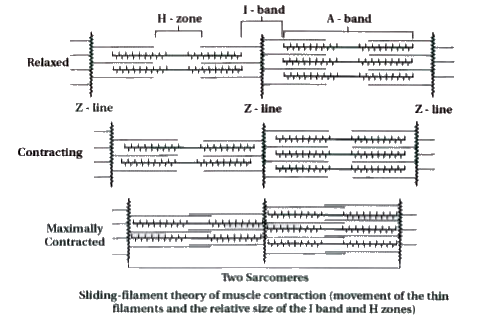Describe the mechanism of muscle contraction with diagram. Solution in Gujrati
Mechanism of muscle contraction is best explained by the sliding filament theory which states that contraction of a muscle fibre takes place by the sliding of the thin filaments over the thick filaments.
This theory was postulated by A.F. Huxely and J.Jensen.
Muscle contraction is initiated by a signal sent by the central nervous system (CNS) via a motor neuron.
A Motor neuron alongwith the muscle fibres connected to it constitute a motor unit. The junction between a motor neuron and the sarcolemma of the muscle fibre is called the neuromuscular junction.
A neural signal reaching this junction release a neurotransmitter (Acetyl choline) which generates an action potential in the sarcolemma. This spreads through the muscle fibre and causes the release of into the sarcoplasm.
Increase in level leads to the binding of with a subunit of troponin on actin filaments and thereby remove the masking of active sites for myosin.
Utilising the energy from ATP hydrolysis, the myosin head now binds to exposed active sites on actin to form a cross bridge.
This pulls the attached actin filaments towards the centre of .A. bands. The .Z. line attached to these actins are also pulled inwards thereby causing a shortening of the sarcomere, i.e., contraction.
It is clea from the above steps, that during shortening of the muscle, (contraction, the .I. bands gets reduced where as the .A. bands retain the length.
The myosin, releasing the ADP and goes back to its relaxed state. A new ATP binds and the cross-bridge is broken.
The ATP is again hydrolysed by the myosin head and the cycle of cross bridge formation and breakage is repeated causing further sliding. The process continues till the ions are pumped back to the sarcoplasmic cisternae resulting in the masking of actin filaments. This caused the retuen of .Z. lines back to their original position (i.e., relaxation).
The reaction time of the fibres can vary in different muscles, Repeated activation of the muscles can lead to the accumulation of lactic acid due to anarobic breakdown of glycogen in them, causing fatigue.

Topper's Solved these Questions
- LOCOMOTION AND MOVEMENT Book:KUMAR PRAKASHANChapter:LOCOMOTION AND MOVEMENT Exercise:SECTION B (Difference /Scientific Reasons)
Explore 7 Videos
- LOCOMOTION AND MOVEMENT Book:KUMAR PRAKASHANChapter:LOCOMOTION AND MOVEMENT Exercise:SECTION -C (Defination /Explanation -terms /Location -Function /Full Name )
Explore 17 Videos
- DIGESTION AND ABSORPTIONBook:KUMAR PRAKASHANChapter:DIGESTION AND ABSORPTIONExercise:Question from Module (Question Paper)
Explore 11 Videos
- MINERAL NUTRITIONBook:KUMAR PRAKASHANChapter:MINERAL NUTRITIONExercise:QUESTIONS FOR MODULE (IMPORTANT MCQ FOR NEET)
Explore 4 Videos
Similar Questions
Pectoral girdle and pelvic girdle
View SolutionSkletal muscles
View SolutionWhy are villi present in the intestine and not in the stomach ?
View SolutionWhich enzyme is essential for the formation of nitrogen?
View SolutionMechanism Of Muscle Contraction
View SolutionThe following diagram (Figure 20, 35) describes the muscle contraction . Identify A to D
View SolutionDescribe the important steps in muscle contraction.
View SolutionGiven an idea about mechanism of muscle contracting along with a suitable diagram.
View Solutionमानव में होने वाली पाचन की क्रियाविधि का सचित्र वर्णन कीजिएए।
View Solutionपेशीय संकुचन के प्रमुख चरणों का वर्णन कीजिये।
View SolutionDescribe the important steps in muscle contraction.
View Solutionव्यसन के प्रमुख कारणों का वर्णन कीजिए।
View SolutionMechanism of Muscle Contraction
View SolutionDescribe the important steps in muscle contraction.
View SolutionDescribe mechanism of muscle contraction.
Or What is sarcomere ? Discuss the mechanism of contraction of a skeletal muscle.
Or Describe molecular mechanism of muscle contraction.
View Solution

